Chemical Coordination and Integration | Science & Technology for UPSC CSE PDF Download
| Table of contents |

|
| Introduction |

|
| Endocrine Glands and Hormones |

|
| Human Endocrine System |

|
| Hormones of Heart, Kidney, and Gastrointestinal Tract |

|
| Mechanism of Hormone Action |

|
Introduction
The neural system enables quick and precise communication between organs, but its effects are temporary. Since nerve fibers do not reach every cell in the body and cellular activities require constant regulation, a different form of coordination is necessary. This is where hormones come into play. Hormones provide the necessary coordination and integration of cellular functions. The neural system and the endocrine system work together to regulate and coordinate physiological functions in the body.
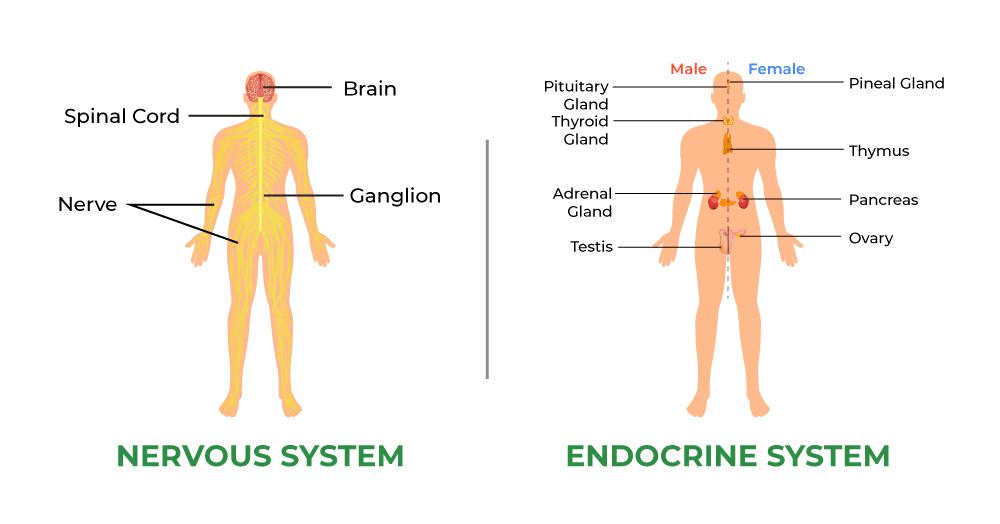
Endocrine Glands and Hormones
- Endocrine glands are known as ductless glands because they do not have ducts. Instead, they release their secretions, called hormones, directly into the bloodstream.
- Hormones were traditionally defined as chemicals produced by endocrine glands, released into the blood, and transported to distant target organs. However, the current scientific definition is broader: Hormones are non-nutrient chemicals that act as intercellular messengers and are produced in small amounts. This new definition includes various molecules beyond those secreted by organized endocrine glands.
- Invertebrates have simple endocrine systems with a few hormones, while vertebrates have a wide range of chemicals acting as hormones for coordination.
The human endocrine system is more complex and involves various glands and hormones that play crucial roles in regulating different bodily functions.
Human Endocrine System
- The human endocrine system is made up of various glands and tissues in the body that produce hormones. These include both organized endocrine glands and hormone-producing cells located in different organs.
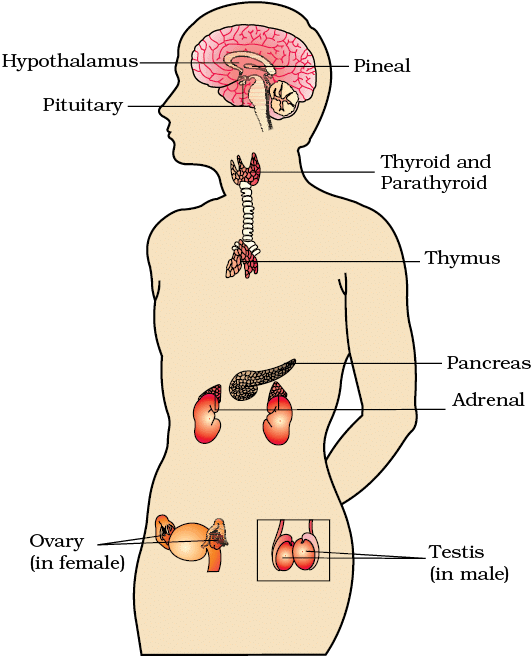 Location of endocrine glands
Location of endocrine glands
- The main endocrine glands in the body are the pituitary, pineal, thyroid, adrenal, pancreas, parathyroid, thymus, and gonads (testes in males and ovaries in females).
- In addition to these glands, other organs such as the gastrointestinal tract, liver, kidney, and heart also produce hormones.
- The hypothalamus, which is part of the brain, plays a crucial role in regulating the endocrine system and is included in the study of major endocrine glands.
In the following sections, we will discuss the structure and functions of all the major endocrine glands and the hypothalamus in detail.
1. Hypothalamus
- The hypothalamus, located at the base of the diencephalon in the forebrain, plays a crucial role in regulating various body functions.
- Within the hypothalamus are several groups of neurosecretory cells known as nuclei, which produce hormones that regulate the synthesis and secretion of pituitary hormones.
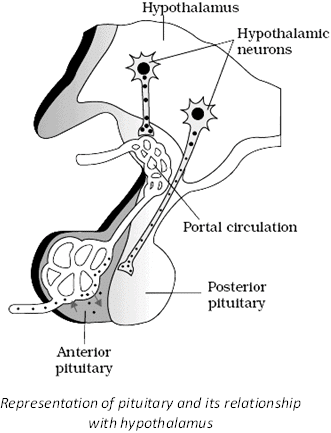
There are two types of hormones produced by the hypothalamus:
- Releasing Hormones: These hormones stimulate the secretion of pituitary hormones. For example, Gonadotrophin-Releasing Hormone (GnRH) from the hypothalamus prompts the pituitary to synthesize and release gonadotrophins.
- Inhibiting Hormones: These hormones inhibit the secretion of pituitary hormones. For instance, somatostatin from the hypothalamus inhibits the release of growth hormone from the pituitary.
The hormones produced by hypothalamic neurons travel through axons and are released from their nerve endings. They reach the pituitary gland through a portal circulatory system, where they regulate the functions of the anterior pituitary. The posterior pituitary, on the other hand, is directly regulated by the hypothalamus through neural connections.
2. The Pituitary Gland
The pituitary gland is a small organ located within a bony cavity known as the sella turcica. It is connected to the hypothalamus by a stalk. The pituitary gland is anatomically divided into two main parts: the adenohypophysis and the neurohypophysis.
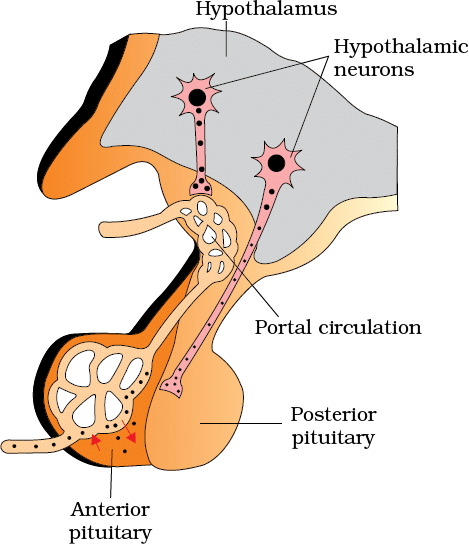 Diagrammatic representation of pituitary and its relationship with hypothalamus
Diagrammatic representation of pituitary and its relationship with hypothalamus
Adenohypophysis
- The adenohypophysis consists of two portions: the pars distalis and the pars intermedia.
- The pars distalis, commonly known as the anterior pituitary, produces several important hormones, including:
- Growth hormone (GH). Regulates growth and development.
- Prolactin (PRL). Promotes milk production in mammary glands.
- Thyroid-stimulating hormone (TSH). Stimulates the thyroid gland to produce thyroid hormones.
- Adrenocorticotropic hormone (ACTH). Stimulates the adrenal cortex to produce glucocorticoid hormones.
- Luteinizing hormone (LH) and Follicle-stimulating hormone (FSH). Regulate gonadal activity.
- The pars intermedia secretes melanocyte-stimulating hormone (MSH), which regulates skin pigmentation. In humans, the pars intermedia is often merged with the pars distalis.
Neurohypophysis
- The neurohypophysis, also known as the posterior pituitary, stores and releases two hormones: oxytocin and vasopressin (antidiuretic hormone, ADH). These hormones are synthesized by the hypothalamus and transported to the neurohypophysis for storage and release.
Disorders Related to Pituitary Hormones
- Over-secretion of GH can lead to abnormal growth conditions such as gigantism in children and acromegaly in adults, characterized by severe disfigurement, especially of the face.
- Low secretion of GH results in stunted growth and a condition known as pituitary dwarfism.
Functions of Pituitary Hormones
- Prolactin is responsible for regulating the growth of mammary glands and the production of milk.
- TSH stimulates the synthesis and secretion of thyroid hormones from the thyroid gland.
- ACTH stimulates the synthesis and secretion of glucocorticoid hormones from the adrenal cortex.
- LH and FSH are known as gonadotropins because they stimulate gonadal activity. In males, LH stimulates the production of androgens, while FSH and androgens regulate spermatogenesis. In females, LH induces ovulation and maintains the corpus luteum, while FSH stimulates the growth and development of ovarian follicles.
- MSH acts on melanocytes to regulate skin pigmentation.
- Oxytocin stimulates smooth muscle contractions. In females, it triggers strong uterine contractions during childbirth and milk ejection from the mammary glands.
- Vasopressin (ADH) primarily acts on the kidneys to promote the reabsorption of water and electrolytes, reducing water loss through urine. An impairment in ADH synthesis or release can lead to a condition known as Diabetes Insipidus, characterized by excessive water loss and dehydration.
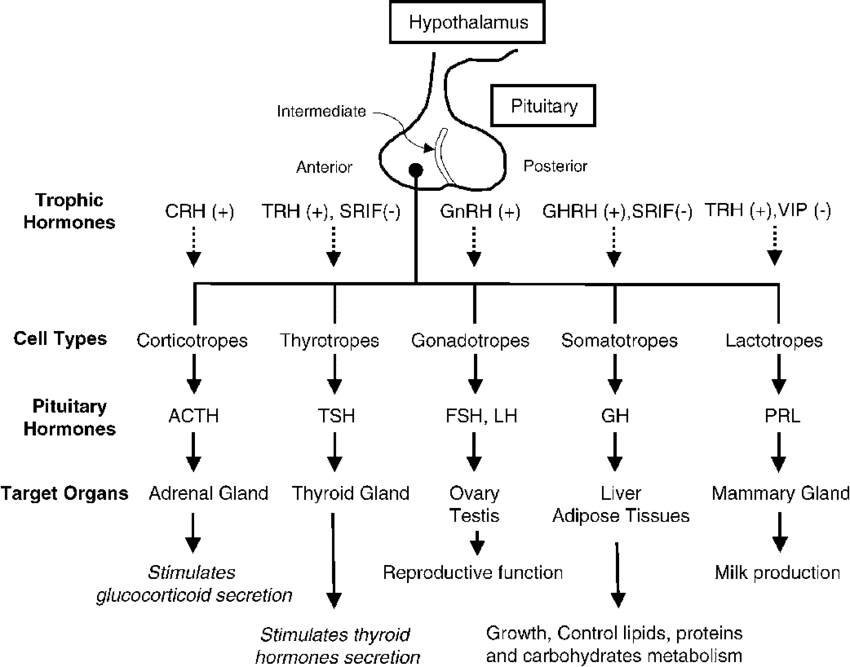
3. The Pineal Gland
- The pineal gland is located on the dorsal side of the forebrain.
- The pineal secretes a hormone called melatonin.
- Melatonin plays a very important role in the regulation of a 24-hour (diurnal) rhythm of our body.
- For example, it helps in maintaining the normal rhythms of the sleep-wake cycle and body temperature.
- In addition, melatonin also influences metabolism, pigmentation, the menstrual cycle as well as our defense capability.
4. Thyroid Gland
- The thyroid gland consists of two lobes situated on either side of the trachea, connected by a thin flap of connective tissue known as the isthmus.
- It is made up of follicles and stromal tissues. Each thyroid follicle contains follicular cells that produce two hormones: tetraiodothyronine (T4) and triiodothyronine (T3).
- Iodine is crucial for the proper synthesis of these hormones. A deficiency in iodine can lead to hypothyroidism and enlargement of the thyroid gland, a condition commonly referred to as goitre.
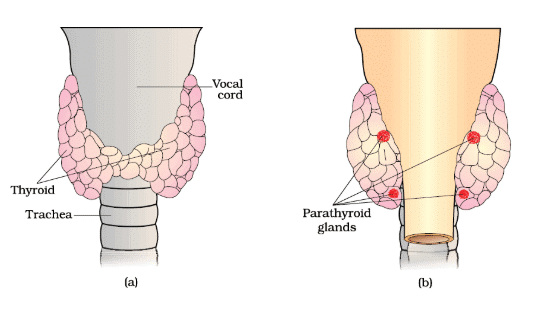
Diagrammatic view of the position of Thyroid and Parathyroid(a) Ventral side(b) Dorsal side
Effects of Hypothyroidism
- During Pregnancy: Hypothyroidism can result in impaired development and maturation of the fetus, leading to conditions such as cretinism, mental retardation, low intelligence quotient, abnormal skin, and deaf-mutism.
- In Adult Women: Hypothyroidism may cause irregularities in the menstrual cycle.
Hyperthyroidism
- Hyperthyroidism can occur due to cancer of the thyroid gland or the development of nodules, leading to an abnormally high rate of synthesis and secretion of thyroid hormones.
- Exophthalmic Goitre: This is a form of hyperthyroidism characterized by the enlargement of the thyroid gland, protrusion of the eyeballs, increased basal metabolic rate, and weight loss. It is also known as Graves’ disease.
Functions of Thyroid Hormones
- Regulation of Basal Metabolic Rate (BMR)
- Support of Red Blood Cell Formation
- Control of Metabolism of Carbohydrates, Proteins, and Fats
- Influence on Water and Electrolyte Balance
Thyrocalcitonin (TCT)
- The thyroid gland also secretes a protein hormone called thyrocalcitonin (TCT), which plays a role in regulating blood calcium levels.
5. Parathyroid Gland
- In humans, there are four parathyroid glands located on the backside of the thyroid gland, with one pair in each lobe of the thyroid.
- These glands are responsible for producing a peptide hormone known as parathyroid hormone (PTH).
- The release of PTH is regulated by the levels of calcium ions in the blood.
- PTH plays a crucial role in increasing calcium (Ca+ 2)levels in the bloodstream. It does this by:
- Stimulating Bone Resorption: PTH acts on bones to promote the process of bone resorption, which involves the dissolution and demineralization of bone tissue. This releases calcium into the bloodstream.
- Enhancing Renal Reabsorption: PTH also stimulates the reabsorption of calcium by the renal tubules in the kidneys, preventing its loss in urine.
- Increasing Calcium Absorption: Additionally, PTH increases the absorption of calcium from digested food in the intestines.
- Overall, PTH is a hypercalcemic hormone, meaning it increases blood calcium levels.
- Along with calcitonin (TCT), PTH plays a significant role in regulating calcium balance in the body.
6. Thymus
- Thymus The thymus gland is a lobular structure located between lungs behind sternum on the ventral side of aorta.
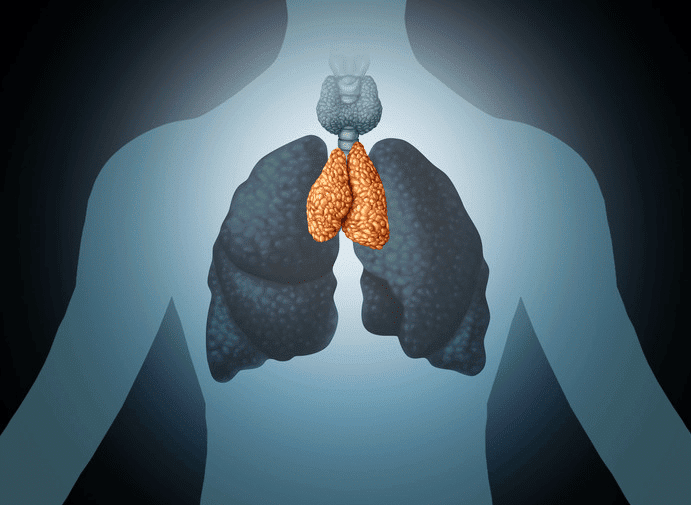
- The thymus plays a major role in the development of the immune system.
- This gland secretes the peptide hormones called thymosins.
- Thymosins play a major role in the differentiation of T-lymphocytes, which provide cell-mediated immunity.
- In addition, thymosins also promote production of antibodies to provide humoral immunity.
- Thymus is degenerated in old individuals resulting in a decreased production of thymosins.
- As a result, the immune responses of old persons become weak.
7. Adrenal Gland
The adrenal glands consist of two types of tissues:
- Adrenal Medulla: This is the central part of the gland.
- Adrenal Cortex: This is the outer part of the gland.
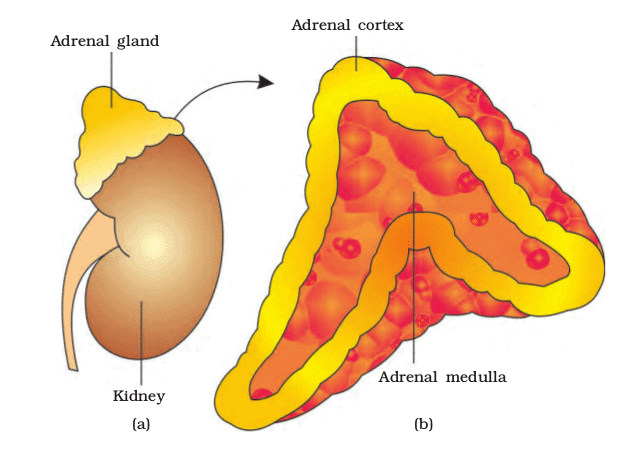 Diagrammatic representation of : (a) Adrenal gland above kidney (b) Section showing two parts of adrenal gland
Diagrammatic representation of : (a) Adrenal gland above kidney (b) Section showing two parts of adrenal gland
Hormones and Their Functions:
- Adrenal Medulla: The adrenal medulla produces hormones called catecholamines, including adrenaline (epinephrine) and noradrenaline (norepinephrine). These hormones are released quickly in response to stress and emergency situations.
- Adrenal Cortex: The adrenal cortex produces various hormones known as corticoids.
(i) Glucocorticoids:These hormones, such as cortisol, are involved in carbohydrate metabolism. They stimulate processes like gluconeogenesis (the production of glucose from non-carbohydrate sources), lipolysis (the breakdown of fats), and proteolysis (the breakdown of proteins). Glucocorticoids also inhibit the uptake and use of amino acids by cells. Additionally, cortisol plays a role in maintaining cardiovascular and kidney functions, producing anti-inflammatory reactions, suppressing immune responses, and stimulating red blood cell (RBC) production.
(ii) Mineralocorticoids: The main mineralocorticoid in the body is aldosterone. This hormone regulates the balance of water and electrolytes by acting on renal tubules. Aldosterone promotes the reabsorption of sodium (Na+) and water, as well as the excretion of potassium (K+) and phosphate ions. This helps maintain electrolyte balance, body fluid volume, osmotic pressure, and blood pressure.
Adrenal Cortex Layers:
- The adrenal cortex can be divided into three layers:
- Zona Reticularis: The innermost layer.
- Zona Fasciculata: The middle layer.
- Zona Glomerulosa: The outer layer.
Addison’s Disease:
- When the adrenal cortex produces insufficient hormones, it can disrupt carbohydrate metabolism, leading to symptoms like acute weakness and fatigue. This condition is known as Addison’s disease.
Functions of Catecholamines:
- Increase alertness
- Cause pupil dilation
- Trigger piloerection (raising of hairs)
- Stimulate sweating
- Increase heart rate, strength of heart contractions, and respiratory rate
- Stimulate the breakdown of glycogen, leading to increased blood glucose levels
- Promote the breakdown of lipids and proteins
8. Pancreas
The pancreas is a gland that has both exocrine and endocrine functions. ( Figure 19.1 ) The endocrine part of the pancreas is made up of clusters of cells called the Islets of Langerhans. There are about 1 to 2 million of these islets in a typical human pancreas, but they make up only 1 to 2 percent of the total pancreatic tissue.
The Islets of Langerhans contain two main types of cells:
- α-cells, which produce a hormone called glucagon.
- β-cells, which produce insulin.
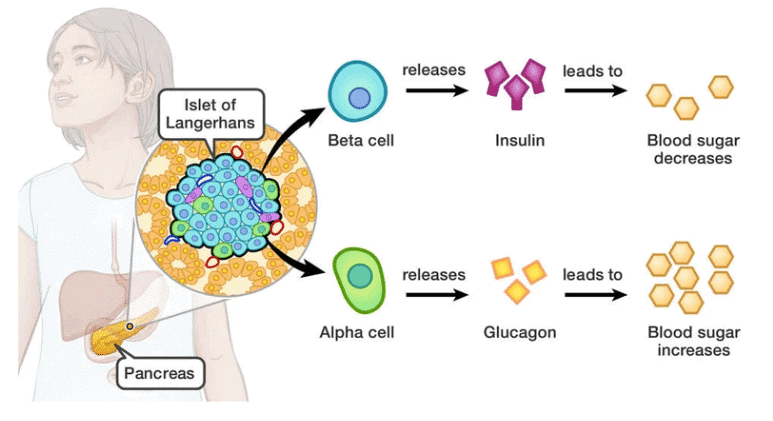
Glucagon is a hormone that helps raise blood sugar levels. It does this by:
- Stimulating the liver to break down glycogen into glucose, a process called glycogenolysis.
- Promoting the production of glucose from non-carbohydrate sources in the liver, known as gluconeogenesis.
- Reducing the uptake and use of glucose by other cells in the body.
- This makes glucagon a hyperglycemic hormone, meaning it increases blood sugar levels.
Insulin, on the other hand, lowers blood sugar levels by:
- Increasing the uptake and use of glucose by liver cells ( hepatocytes. and fat cells ( adipocytes );
- Stimulating the conversion of glucose into glycogen for storage in these cells, a process called glycogenesis.
Together, insulin and glucagon maintain the balance of glucose in the blood.
When blood sugar levels are too high for a long time, it can lead to a condition called diabetes mellitus. This condition is characterized by the loss of glucose in urine and the production of harmful substances called ketone bodies. People with diabetes are often treated with insulin therapy to help control their blood sugar levels.
9. Testis
- A pair of testis is present in the scrotal sac (outside abdomen) of male individuals.
- Testis performs dual functions as a primary sex organ as well as an endocrine gland.
- The Leydig cells or interstitial cells, which are present in the intertubular spaces produce a group of hormones called androgens mainly testosterone.
- Androgens regulate the development, maturation and functions of the male accessory sex organs like epididymis, vas deferens, seminal vesicles, prostate gland, urethra etc.
- These hormones stimulate muscular growth, growth of facial and axillary hair, aggressiveness, low pitch of voice etc.
- Androgens play a major stimulatory role in the process of spermatogenesis (formation of spermatozoa).
- Androgens act on the central neural system and influence the male sexual behaviour (libido).
- These hormones produce anabolic (synthetic) effects on protein and carbohydrate metabolism.
10. Ovary
- Location and Function: Females have a pair of ovaries situated in the abdomen. The ovary is the main female reproductive organ responsible for producing one ovum (egg) during each menstrual cycle.
- Hormone Production: The ovary also produces two groups of steroid hormones: estrogen and progesterone.
- Composition: The ovary is made up of ovarian follicles and stromal tissue.
- Estrogen: Estrogen is primarily synthesized and secreted by the growing ovarian follicles. This hormone has various effects, including:
- Stimulating the growth and activity of female secondary sex organs.
- Promoting the development of growing ovarian follicles.
- Inducing the appearance of female secondary sexual characteristics, such as a higher pitch of voice.
- Supporting the development of mammary glands and regulating female sexual behavior.
- Progesterone: After ovulation, the ruptured follicle is transformed into the corpus luteum, which primarily secretes progesterone. This hormone is crucial for:
- Supporting pregnancy.
- Stimulating the formation of milk-storing alveoli and milk secretion in mammary glands.
Hormones of Heart, Kidney, and Gastrointestinal Tract
1. Atrial Natriuretic Factor (ANF)
- ANF is a peptide hormone secreted by the atrial wall of the heart.
- It plays a crucial role in decreasing blood pressure.
- When blood pressure increases, ANF is released, causing dilation of blood vessels, which helps to reduce blood pressure.
2. Erythropoietin (EPO)
- Erythropoietin is a peptide hormone produced by the juxtaglomerular cells of the kidney.
- It stimulates erythropoiesis, the formation of red blood cells (RBCs).
3. Hormones of the Gastrointestinal Tract
- The gastro-intestinal tract secretes several important peptide hormones, including:
- Gastrin. Stimulates the secretion of hydrochloric acid and pepsinogen from gastric glands.
- Secretin. Stimulates the exocrine pancreas to secrete water and bicarbonate ions.
- Cholecystokinin (CCK). Stimulates the secretion of pancreatic enzymes and bile juice from the gall bladder.
- Gastric Inhibitory Peptide (GIP). Inhibits gastric secretion and motility.
4. Growth Factors
- Several non-endocrine tissues secrete hormones known as growth factors.
- These factors are essential for the normal growth of tissues and their repair or regeneration.
Mechanism of Hormone Action
- Hormones exert their effects on target tissues by binding to specific proteins known as hormone receptors, which are located only in the target tissues.
- There are two types of hormone receptors:
- Membrane-bound receptors: These receptors are found on the cell membrane of the target cells.
- Intracellular receptors: These receptors are located inside the target cell, primarily in the nucleus, and are often referred to as nuclear receptors.
- When a hormone binds to its specific receptor, it forms a hormone-receptor complex. This complex is crucial because each receptor is specific to one hormone, highlighting the specificity of hormone action.
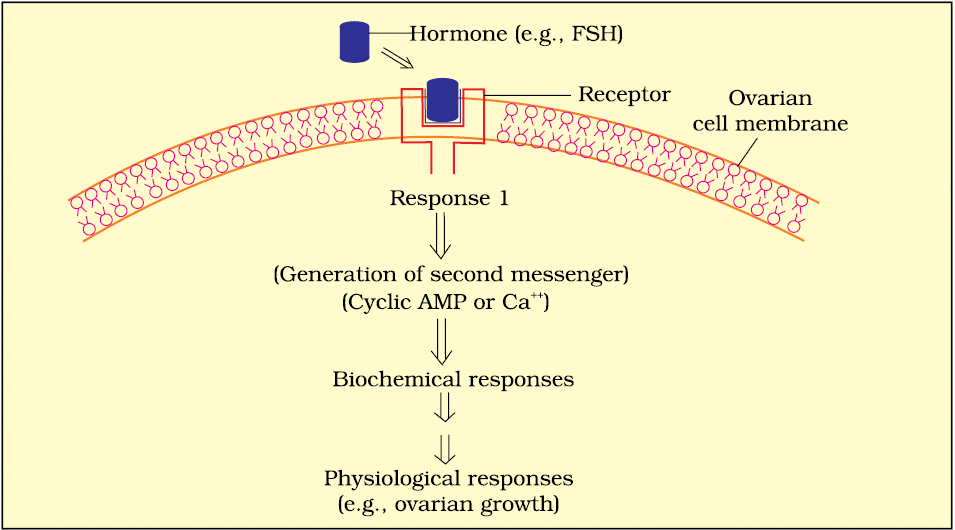 Diagrammatic Representation of Hormone Action : Protein Hormone
Diagrammatic Representation of Hormone Action : Protein Hormone
- The formation of the hormone-receptor complex triggers a series of biochemical changes in the target tissue, regulating its metabolism and physiological functions.
- Hormones can be classified into different groups based on their chemical nature:
- Peptide, polypeptide, and protein hormones: Examples include insulin, glucagon, pituitary hormones, and hypothalamic hormones.
- Steroid hormones: Examples include cortisol, testosterone, estradiol, and progesterone.
- Iodothyronines: These are thyroid hormones.
- Amino acid derivatives: An example is epinephrine.
- Hormones that interact with membrane-bound receptors typically do not enter the target cell. Instead, they generate second messengers, such as cyclic AMP, IP3, or calcium ions, which regulate cellular metabolism.
- On the other hand, hormones that interact with intracellular receptors, such as steroid hormones and iodothyronines, primarily regulate gene expression or chromosome function. This occurs through the interaction of the hormone-receptor complex with the cell's genome.
 Diagrammatic Representation of Hormone Action
Diagrammatic Representation of Hormone Action
- The cumulative biochemical actions initiated by hormone-receptor binding result in various physiological and developmental effects in the target tissue.
|
90 videos|490 docs|209 tests
|
FAQs on Chemical Coordination and Integration - Science & Technology for UPSC CSE
| 1. What is the endocrine system and what are its primary functions? |  |
| 2. What are hormones and how do they affect the body? |  |
| 3. How do hormones differ from enzymes? |  |
| 4. What is the difference between hormones and vitamins? |  |
| 5. What are the mechanisms through which hormones act on target cells? |  |
















